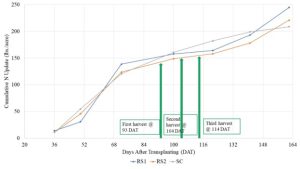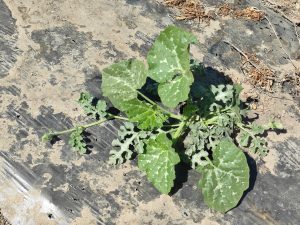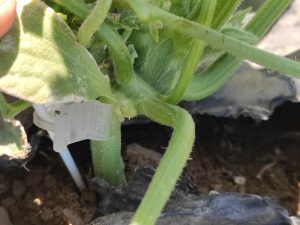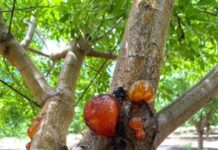
You will probably not surprise to see the grafting of fruit and nut tree crops and well understand the needs to do so. But when I am going to discuss watermelon grafting here, I am sure many of you may pause and ask, “Can watermelon graft? What is that? Why graft watermelons? Is it still sweet after grafting? Is it still watermelon?”
Why Graft Watermelons?
The main purpose of grafting watermelons is to deliver plant traits to farms much faster than the traditional breeding programs. It is NOT designed to replace breeding and other well-documented techniques of developing new cultivars; rather, it offers growers and consultants a quicker and unique way to solve production problems. In contrast to the traditional breeding system, a grafted watermelon seedling comes from the recombination of two different plant species into one physical (not genetic) hybrid (Figure 1). The phenotypic traits that are brought to farms after grafting include soilborne disease resistance, abiotic stress tolerance, greater nutrient and water use efficiency, higher fruit yield and better fruit quality.
Do I Need Grafted Watermelons?
This is a question you should always ask before making a decision. The following are some of the benefits from using grafted watermelons. If you have the related issues but with limited solutions, you may consider grafting as your “icebreaker”. Again, please be mindful that these benefits may not be observed at each farm. Using grafting must be proceeded in a case-by-case protocol.
Grafted watermelon can have a stronger resistance to soilborne diseases (e.g., Fusarium wilt, Fusarium crown and root rot, Verticillium wilt, etc.)
Grafted watermelon can produce a higher fruit yield under soilborne pathogenic pressure than non-grafted plants.
Grafted watermelon can produce a higher fruit yield under low-disease or disease-free conditions.
Grafted watermelon can use water and nutrients differently compared to non-grafted plants.
Grafted watermelon may have better fruit quality than non-grafted plants.
Where to Find Rootstock Information and How to Graft?
A majority of the rootstock varieties can be found at vegetablegrafting.org/resources/rootstock-tables/cucurbit-rootstocks/. Please note that 1.) not all cucurbit rootstocks can be grafted onto watermelons; 2.) information about the disease resistance of each rootstock was collected from the seed company; and 3.) the rootstock table may be updated as new or old rootstocks emerge or disappear. In addition to the table, you can also seek help from rootstock seed suppliers, nurseries that work on grafting watermelons, extension advisors and your trusted growers. For information about grafting nurseries, feel free to give me a call or email me (209-525-6822, zzwwang@ucanr.edu) and I will give you a list. If you need to know the grafting methods, check out the grafting manual at vegetablegrafting.org/resources/grafting-manual/.
Possible Challenges and Pitfalls
Using grafted watermelons can be challenging. Such challenges can be serious under some, though rare, circumstances.
Cost
In the past, growers only dealt with scion, but now they must think about rootstocks. Paying extra money for the rootstock seeds and producing grafted transplants will definitely increase the production cost. Currently, the most effective way in balancing the cost is to plant grafted watermelons in a wider spacing while still managing them for a higher fruit yield. Nowadays in California, grafted watermelons should be planted in a 4- to 5-foot in-row spacing, which is equivalent to 1,200 to 1,500 plants per acre compared to 2,200 plants per acre for the non-grafted plants.
Extended vegetative growth and delayed harvest
Due to their stronger rootability and growth vigor, grafted watermelons usually produce more and larger canopies than regular plants, possibly resulting in delayed fruit maturity. Also, the typical exterior changes that indicate fruit maturity (e.g., a dried tendril and leaflet) on non-grafted watermelons may not be true for grafted plants. An early harvest that causes a lower sugar content can occur frequently in grafted fields. From our past observations as well as research from other areas, a possible 7- to 10-day delay from non-grafted plants could be reasonable for harvesting grafted watermelons.
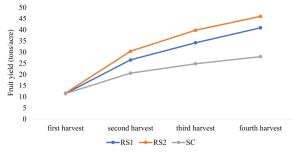
Yield advantage at later harvests
If you don’t see a higher yield at your first harvest or even a lower yield, be patient and the longer harvest window of grafted plants will give you the subsequent melons. Figures 2 and 3 were from my previous trials in 2021 and 2022 and indicated the yield superiority in the subsequent harvests for grafted plants (Figure 2) and the duration for grafted plants to maintain canopy compared to non-grafted plants (Figure 3).
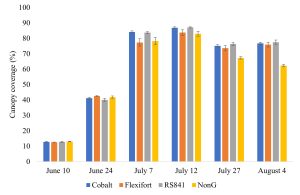
Different responses to irrigation and fertilization
With the changes of growth characteristics, you may need to consider adjusting your irrigation and fertilization to meet the needs of grafted watermelons. Figure 4 was also from a field trial in 2022 and showed the different canopy regrowth after supplying with irrigation after each harvest between grafted and non-grafted watermelons. It is obvious to see that the canopy of non-grafted watermelons was consistently lower than the grafted plants since the start of fruit harvest on mid-July 2022 (Figure 4). In the meantime, grafted watermelons may take up nitrogen differently from the non-grafted watermelons as well. Figure 5 was a trial I conducted in 2021 which demonstrated the different patterns of nitrogen uptake between grafted and non-grafted watermelons, especially at the last part of the growth cycle.
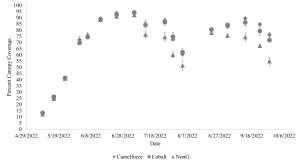
Scion-rootstock incompatibility and change of fruit exterior and interior quality
This is a complex question. In many cases, you will not be able to detect the incompatibility until the plants are transplanted or even when fruits are harvested and cut open. Symptoms of incompatibility early in the season could have 1.) poor early growth compared to other combinations and the non-grafted control; 2.) death after a few days of transplanting; 3.) incomplete removal of rootstock shoot part at grafting (Figure 6); and 4.) deformed plants. Of course, some of the symptoms may look similar to pathogen infestations. Symptoms of grafting incompatibility at a later stage of the growth cycle usually include a much lower final yield compared to others and a significant reduction in fruit quality (e.g., smell, flesh color, sweetness and hollow heart). For fruit quality, most noticeable changes after grafting that you may see or taste include thicker rinds, bigger fruit and firmer flesh. Therefore, preparing accordingly to meet your needs and your customer’s preference is important.
